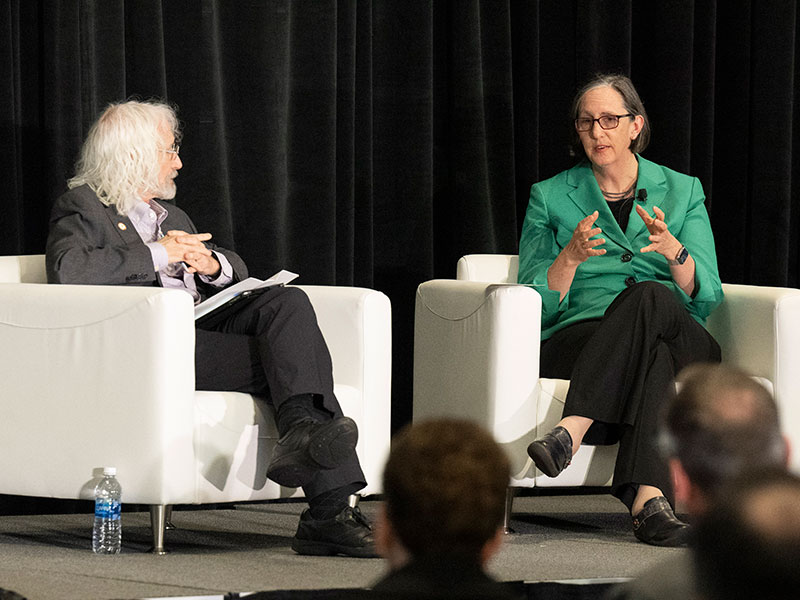NCI Director lays out new framework for tackling cancer at multiple levels

W. Kimryn Rathmell, MD, PhD, has been director of the National Cancer Institute (NCI) for just over three and a half months. Moving from life as a clinical investigator and academic healthcare administrator to sit at the head of the world’s largest cancer table, she has seen just how quickly the world is changing and how much remains to change.
The Cancer Moonshot was initially funded through the 21st Century Cures Act passed in 2016. The reignited Cancer Moonshot, kickstarted in 2022, is already transforming the way government approaches cancer. Agencies as diverse as the NCI, Department of Energy, and Veterans Administration are learning the advantages of sharing information.
“The reignited Cancer Moonshot is this whole-of-government approach,” Rathmell said during the NCI Director’s Address and Fireside Chat with AACR Immediate Past President Philip D. Greenberg, MD, FAACR, on Monday, April 8, at the American Association for Cancer Research (AACR) Annual Meeting 2024. “The approach of putting everyone at the same table and really ensuring that all of government is working together is a major cultural shift and is working remarkably well.”
The session is available on demand for registered AACR attendees through July 10, 2024, on the virtual meeting platform.
Funding for cancer research is essential to advance cancer prevention, diagnosis, and treatment. The federal budget for fiscal year (FY) 2024 gave NCI a $120 million increase in total appropriation over the base budget in FY 2023. The final year of new appropriations for the NCI component of the Cancer Moonshot was 2023, which provided an additional $216 million. However, the net difference in the NCI’s funding for FY 2024 compared to FY 2023 is a decrease of $96 million.
“We’re essentially flat, and it’s feeling like less because it costs more to do everything every day,” Rathmell said. “I always thought that if I were just the NCI director, I would fix it all. It turns out it’s hard.”
The fix is recognizing that cancer is changing much as society is changing. The NCI can support the status quo or recognize the seismic changes in society across the United States and around the world and embrace those changes proactively.
The Cancer Moonshot calls for a 50 percent reduction in cancer mortality in the next 25 years. The reality, Rathmell noted, is that cancer mortality in the U.S. has been falling since the 1990s thanks to immunotherapies, new targeted therapies, more effective treatments for some of the hardest-to-treat cancers, increased representation and diversity in cancer trials and research, and more.
But cancer incidence rates for those younger than 40 in the U.S. have been climbing steadily over the same period.
“Cancer doesn’t stand still; we have to keep up with a constantly changing field around us—and not just keep up, but learn how to stay one step ahead,” Rathmell said.
She also noted other challenges, including a changing workforce, issues around trust in science and medicine, and how to communicate with the public. And although there have been gains in reaching marginalized populations, there continues to be widespread disparities affecting cancer care in the United States and beyond.
The National Cancer Plan is a roadmap for the kinds of changes needed to improve the health of Americans from the perspective of cancer, she continued. The ultimate goals are improved health outcomes for all by preventing more cancers, detecting more cancers earlier, developing more effective treatments, and delivering optimal care.
Those health-centric goals are powered by what she called empowering goals: maximizing data utility, eliminating inequities, optimizing the workforce, and engaging everyone. Discovery science is the fuel that powers the entire machine to improve health outcomes. The most effective way to move forward is to drive innovative collaborations.
Rathmell finds innovation by looking at the spaces between traditional fields and functions within the cancer community. Just as 3D cancer atlases use spatial-omics to map cancer through space and time at the cellular and molecular levels, the NCI and the rest of the cancer community should be thinking and acting between the spaces of their traditional areas of interest.
The traditional era of cancer research and treatment developed around narrow, specialized areas that worked from the top down, from basic science to clinicians to patients. The current era is a horizontal effort where team science and interdisciplinary work have become accepted. New technologies and new ways of thinking about research are the expectation rather than the exception.
“Our next era that we are in now would be better defined as 360,” Rathmell said, referring to the concept as “thinking in the spaces, on steroids.” This includes truly cross-sector collaborations, bottom-up research, and engaging every person. It involves broad integration of data—biology with physiology—and learning to understand each other’s language a little better. She noted that there is more and more research that ties molecules into cells, tissues, organs, systems, and the whole person, eventually moving into family units and communities. Being able to use new data utilities to think about how cancer affects every person on those different levels at the same time will move the field closer to a place of unlimited boundaries and unbounded enthusiasm, she said.
“It is not the technology. This is not just the rise of AI or the machines,” Rathmell said of the next era. “This is really still about people. It’s about the patients that we serve. It’s about our mentors and our mentees. It’s about our collaborators and our colleagues. And it’s about our communities. And all of those, together, is how we can make a difference, and leaves me so optimistic about our future.”
More from the AACR Annual Meeting 2025
View a photo gallery of scenes from Chicago, continue the conversation on social media using the hashtag #AACR25, and read more coverage in AACR Annual Meeting News.

